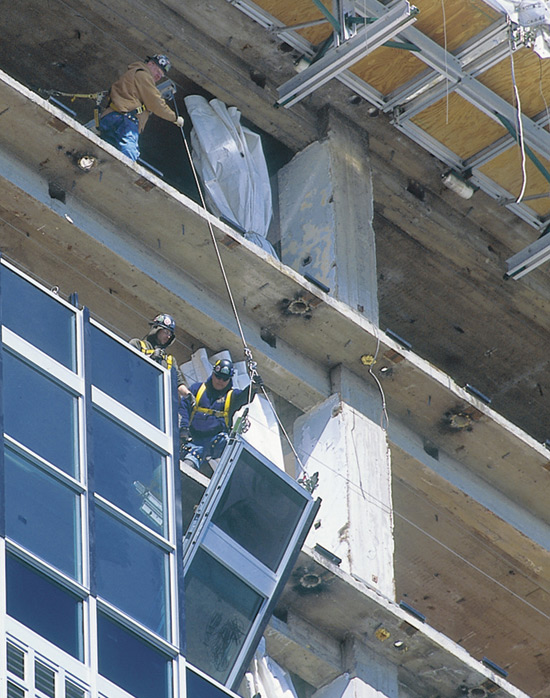More Than One Way to Skin a Building
Matching the look of the original aluminum mullions also proved to be challenging. When the UN was designed in the 1940s, the use of aluminum in architectural windows was relatively new. Stainless steel, on the other hand, had been used quite a bit. So when the original design team specified aluminum they tried to make it look like stainless with a No. 4 finish. “That's not a good finish for aluminum,” says Heintges. “All the scratches get filled with atmospheric contaminates and it starts to get dirty and pitted.” The recladding team couldn't find a manufacturer who would finish aluminum in that way, so it compromised and gave the extrusions a gentler brushed look. Inside the building, the anodized aluminum was left exposed, as it was in the original. On the outside, it was given a protective coating with two types of fluoropolymer paint, one in silver to resemble the look of exposed metal, and the other black, recalling the mullion caps of the original wall.
Construction Process
The old wall was stripped off, the asbestos abated, and the new system installed in three zones. Ornamental ironworkers with the local union worked from a three-story Beeche work access system suspended from the roof via a dedicated aluminum structure, which allowed work to go on in a safe, contained environment. They removed the old glass sashes from the aluminum and steel frames then unbolted the frames from the existing anchors. Reciprocating saws were used to cut frames into more manageable pieces and the threaded studs that remained on the structure were ground smooth. Once this was complete, the ironworkers attached the new panels with connections that go directly to the Secretariat's steel structure. Demolition of the old curtain wall and installation of the new went from the bottom up in three sections starting with the top third of the building, then the middle third, and finally the storefront and bottom third. The new curtain wall followed behind the old by approximately three floors. “Zipper” units were installed at the mechanical floors to join the sections of the facade.
 |
The recladding of the Secretariat is part of a $1.87-billion renovation of the UN’s New York City compound that included the complete replacement of the curtain wall system with much better performance and faithfulness to the original design. Photo by William Rivelli, courtesy of the Ornamental Metal Institute of New York |
The result of the project team's careful design and planning, and the ironworkers' fine craftsmanship, combined with new open-plan interiors by HLW, is a reborn UN, at once a spitting image of its younger self and an example of how far technology has evolved since 1952. “The look of the exterior is pretty consistent with what it was,” says John Gering, AIA, managing partner of HLW, “except for the fact that the original Secretariat had enclosed offices. When you looked inside you saw a wall. Now when you look through the glass you look through an open space.”
Established in 1972 to advance the interests of the architectural, ornamental, and miscellaneous metal industries, the Ornamental Metal Institute of New York sponsors programs to help architects, engineers, builders, developers, and construction managers transform design into reality. www.ominy.org |








